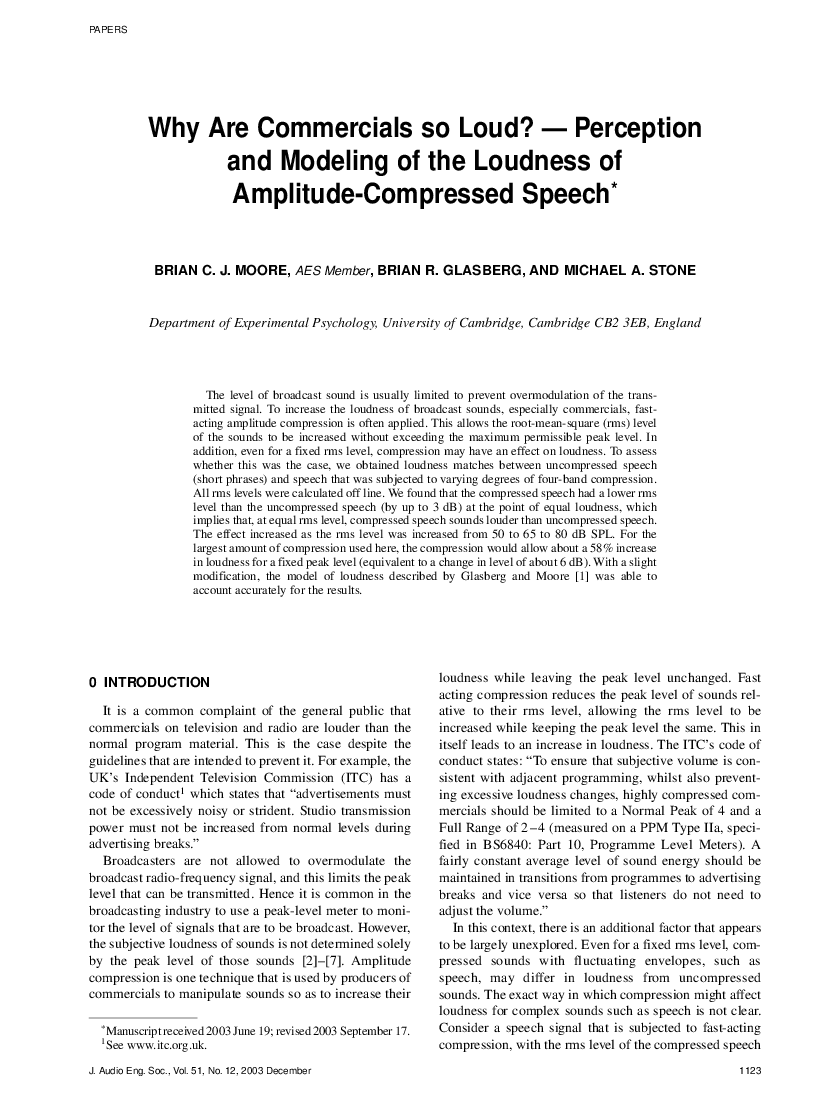Home / Publications / E-library page
You are currently logged in as an
Institutional Subscriber.
If you would like to logout,
please click on the button below.
Home / Publications / E-library page
Only AES members and Institutional Journal Subscribers can download
The level of broadcast sound is usually limited to prevent overmodulation of the transmitted signal. To increase the loudness of broadcast sounds, especially commercials, fastacting amplitude compression is often applied. This allows the root-mean-square (rms) level of the sounds to be increased without exceeding the maximum permissible peak level. In addition, even for a fixed rms level, compression may have an effect on loudness. To assess whether this was the case, we obtained loudness matches between uncompressed speech (short phrases) and speech that was subjected to varying degrees of four-band compression. All rms levels were calculated off line. We found that the compressed speech had a lower rms level than the uncompressed speech (by up to 3 dB) at the point of equal loudness, which implies that, at equal rms level, compressed speech sounds louder than uncompressed speech. The effect increased as the rms level was increased from 50 to 65 to 80 dB SPL. For the largest amount of compression used here, the compression would allow about a 58% increase in loudness for a fixed peak level (equivalent to a change in level of about 6 dB). With a slight modification, the model of loudness described by Glasberg and Moore [1] was able to account accurately for the results.
Author (s): Moore, Brian C. J.; Glasberg, Brian R.; Stone, Michael A.
Affiliation:
Department of Experimental Psychology, University of Cambridge, Cambridge, England
(See document for exact affiliation information.)
Publication Date:
2003-12-06
Import into BibTeX
Permalink: https://aes2.org/publications/elibrary-page/?id=12190
(110KB)
Click to purchase paper as a non-member or login as an AES member. If your company or school subscribes to the E-Library then switch to the institutional version. If you are not an AES member Join the AES. If you need to check your member status, login to the Member Portal.

Moore, Brian C. J.; Glasberg, Brian R.; Stone, Michael A.; 2003; Why Are Commercials so Loud? ' Perception and Modeling of the Loudness of Amplitude-Compressed Speech* [PDF]; Department of Experimental Psychology, University of Cambridge, Cambridge, England; Paper ; Available from: https://aes2.org/publications/elibrary-page/?id=12190
Moore, Brian C. J.; Glasberg, Brian R.; Stone, Michael A.; Why Are Commercials so Loud? ' Perception and Modeling of the Loudness of Amplitude-Compressed Speech* [PDF]; Department of Experimental Psychology, University of Cambridge, Cambridge, England; Paper ; 2003 Available: https://aes2.org/publications/elibrary-page/?id=12190
@article{moore2003why,
author={moore brian c. j. and glasberg brian r. and stone michael a.},
journal={journal of the audio engineering society},
title={why are commercials so loud? ' perception and modeling of the loudness of amplitude-compressed speech*},
year={2003},
volume={51},
issue={12},
pages={1123-1132},
month={december},}
TY – paper
TI – Why Are Commercials so Loud? ' Perception and Modeling of the Loudness of Amplitude-Compressed Speech*
SP – 1123 EP – 1132
AU – Moore, Brian C. J.
AU – Glasberg, Brian R.
AU – Stone, Michael A.
PY – 2003
JO – Journal of the Audio Engineering Society
VO – 51
IS – 12
Y1 – December 2003